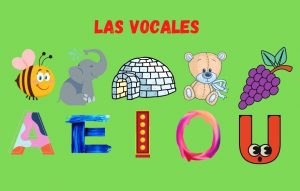1. Vowel Systems in American English and Spanish
OVERVIEW OF THE VOWEL SYSTEMS IN AMERICAN ENGLISH AND SPANISH
Learning Objectives
At the end of this chapter you will:
- Understand the main features of the vowel system of American English.
- Understand the main features of the vowel system of Spanish.
- Be able to differentiate English glidy vowels from Spanish non-glidy vowels.
I. AMERICAN ENGLISH VOWELS
 Correct pronunciation of vowels is a very important aspect of mastering a foreign language. In Spanish, if you pronounce the vowels correctly, you will have taken an enormous step towards native pronunciation. Broadly speaking, phonetics refer to the study of individual sounds, whereas phonology deals with the interaction between sounds. First, let’s take a look at the American English vowels.
Correct pronunciation of vowels is a very important aspect of mastering a foreign language. In Spanish, if you pronounce the vowels correctly, you will have taken an enormous step towards native pronunciation. Broadly speaking, phonetics refer to the study of individual sounds, whereas phonology deals with the interaction between sounds. First, let’s take a look at the American English vowels.
In English, there are five letters that represent vowel sounds. However, there are up to 15 different vowel sounds. Also, you cannot always know how to pronounce them. Yes, English spelling is a delightfully messy matter!
For example:
Listen to these seven examples where the letter “o” has seven different sounds. The speaker will say each word twice:
- to
- go
- got
- some
- woman
- women
- work
English vowels are open and “lazy”, i.e., they require very little tension in the face and mouth to be pronounced. For example: “bad,” “bit,” “let.” They are also “glidy,” which means that a vowel will be pronounced starting with one sound and ending with a different sound, like in the case of “Bob,” “right,” “mate,” etc.

What is the most common sound in English?


Now take the quiz.
II. SPANISH VOWELS

In comparison to English, Spanish is a phonetic language, i.e. its orthography (spelling) has a one-to-one relationship with its pronunciation. That means that words are spelled in exactly the same way as they are pronounced. This is beautiful, isn’t it? And Spanish vowels are also beautiful! There are five letters and only five sounds. That’s it! Vowels sound the same no matter where in the word or the phrase they are located. Furthermore, Spanish vowels, as opposed to their English counterparts, are tense, short, and abrupt.
Please watch this short video concerning the Spanish vowels and then take the quiz below.
Remember, when saying the Spanish vowels you must feel the tension in your face and mouth.


Does SCHWA exist in Spanish?
 No, no, no!!
No, no, no!!
Since schwa is such a common sound in the English language, it is a great challenge for English speakers not to produce it when speaking Spanish. Please note that using it can create confusion. For example, if a person says “buenəs,” their interlocutor would not be sure whether they are saying “buenos” or “buenas”.
III. CONTRASTING GLIDY AND NON-GLIDY VOWELS
As stated above, English vowels are often glidy, whereas Spanish vowels are not. Therefore, correct pronunciation of Spanish vowels can be a challenge for speakers of English. In this section, we will contrast pairs of words in English and Spanish.
| English /ey/ | Spanish /e/ |
| May | Me |
| Say | Se |
| Day | De |
| Lay | Le |
| Kay | Que |
| Re | Re |
| Santa Fe | Santa Fe |
| Forte | Fuerte |
| Megan | Megan |
| English /ow/ | Spanish /o/ |
| no | no |
| Jo | yo |
| taco | taco |
| so | so |
| Mexico | México |
| mode | modo |
| do | do |
| Chicago | Chicago |
| obedient | obediente |

